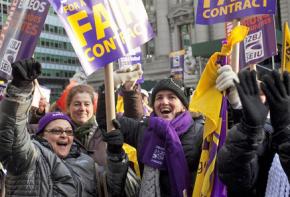A victory for 32BJ
reports on the contract settlement reached by members of SEIU-32BJ, and why the Occupy movement was central to winning a good contract.
THE NEW Year brought the first important victory to a New York City trade union when 22,000 commercial building workers, represented by SEIU-32BJ (32BJ), reached a settlement on a new contract. Given the Occupy Movement's reshaping of the political terrain in NYC and its active organizing efforts in support of these workers, this is a victory for which the movement can take some credit.
32BJ's old contracts were set to expire on January 1, 2012, and the Realty Advisory Board (RAB), which represents the bosses and is dominated by the biggest commercial landlords in New York City, was threatening to force the union to strike if major concessions were not given back to the RAB.
The RAB was seeking three years of zero-wage increases, a two-tier wage system that would limit new hires to 70 percent of the wage rate, no pension benefits and no health insurance coverage for family members, as is currently enjoyed. The RAB was also seeking to deny the union the right to payroll deductions for its political fund. The bosses achieved none of their demands.

The new contract includes a six percent wage increase over four years, plus an additional one-off $1,100 bonus and additional pension benefits. The two-tier wage demand and the other major givebacks for new workers were defeated, as was the RAB's demand to eliminate deductions for the political fund. The tentative agreement also includes some added health and retirement benefits and added safety and job security protections.
THE CONTRACT fight unfolded during months dominated by the struggles of the Occupy movement. Because a strike was averted, it is impossible to say how the participation of Occupy activists would have impacted the strike, but the prospect of hundreds of occupiers joining picket lines at such locations as Rockefeller Center, the NY Stock Exchange, and the Time-Warner building, must have been part of the equation considered by the RAB.
Occupy activists, many active in the Occupy Wall Street Labor Outreach Committee (LOC), were responsible for helping build joint actions by 32BJ and the Transit Workers Union. Similarly, Occupy and LOC activists were instrumental in getting the NYC Central Labor Council (CLC) to call all city unions out in joint action. The result was a "March for Jobs and Economic Fairness" on December 1, 2011, that was notable for being a joint march with no union leadership speakers and was understood to be modeled on the "bottom up" Occupy tactics.
The march coincided with the 32BJ strike authorization vote, and the 32BJ contingent was by far the largest on the march. Notably, in the days leading up to the contract expiration, the CLC also announced that there would be no crossing of picket lines, most importantly by Teamster delivery people.
In comparison to the last 32BJ building cleaners strike in 1996, the union was consistently able to mobilize its membership, and was proactive in building ties to other unions, the CLC, and in preparing for broad picket lines across the city. Planning was also in place for joint actions with Occupy and LOC activists. There can be little question that the Occupy movement, both in creating a favorable political environment to raise the profile of workers struggles, and in concretely providing both foot soldiers and tactical leadership, contributed in important ways to this victory.
Some activists have criticized the contract settlement on the narrow grounds that the wage agreement fails to keep up with the rate of inflation. But they are missing the forest for the trees.
The organizing and collective effort that went into this contract battle represent a step forward for the labor movement as a whole. And while admittedly just one contract in one sector, after 40 years of organized labor retreats, we are beginning to see the outlines of what it will take to win real gains, both material and organizational, for workers.


